
The Farm House, also known as the Knapp–Wilson House, is the oldest building on the campus of Iowa State University in Ames, Iowa. Now a museum open to the general public, this house was built 1861-65 as part of the model farm that eventually became Iowa State. It was designated a National Historic Landmark in 1964 for its association with agriculturist and teacher Seaman A. Knapp and with U.S. Secretary of Agriculture James Wilson, both of whom lived here while teaching at Iowa State.

The Jacob Aldrich House, also known as the J. Aldrich House, is an historic house located at 389 Aldrich Street, in Uxbridge, Massachusetts. On January 20, 1984, it was added to the National Register of Historic Places.

The Capt. Gamaliel Bradford House is a historic house in Duxbury, Massachusetts. Built in 1807, the house is locally distinctive for its brick side walls and monitor section above the hip roof. It was listed on the National Register of Historic Places in 1978.

The Josiah Mason Jr. House is a historic house in Cambridge, Massachusetts.

The Capt. Seth Baker Jr. House is a historic house in Barnstable, Massachusetts, USA. Built about 1850, it is a late example of transitional Federal-Greek Revival architecture, and a somewhat modest house built for a ship's captain. It was listed on the National Register of Historic Places in 1987.
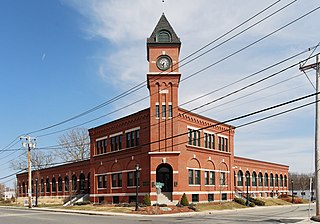
The H.F. Barrows Manufacturing Company Building, now the North Attleborough Police Station, is a historic industrial building in North Attleborough, Massachusetts. The elegant brick building was built in 1905–06, and was home for many years to one of the town's most successful jewelry businesses. It was listed on the National Register of Historic Places in 2001. Today the building serves as the headquarters for the North Attleborough Police Department.
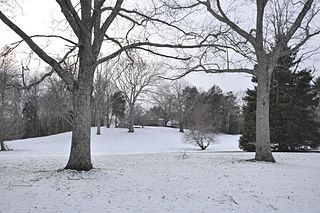
Bramble Hill is a historic house in Rehoboth, Massachusetts. The two-story masonry house was built c. 1923–28 to a design by Providence architect Albert Harkness, and is a locally unique example of the French Norman Revival style. The exterior is in fieldstone, and its interior features extensive mahogany trim. The entry hall has a basket-weave brick floor, and the main hall has a large stone fireplace and parquet floor. It was commissioned by Doris Mather Briggs, a relative of the locally prominent Carpenter family, and is one of the few houses in the town for which an architect is known.

The Seth Boyden House is a historic house at 135 Oak Street in Foxborough, Massachusetts. It is also known as "OAKWUD", after 500-year-old oak tree that stands on the northeast side of the main house. The two story brick house is claimed to have been built as early as 1728, although stylistic architectural evidence suggests a later date. The house is notable as the home of inventor Seth Boyden, who was cited as a significant influence by Thomas Alva Edison.

The Jehiel Cochran House is a historic house at 65 Burnham Road in Andover, Massachusetts. It is listed on the National Register of Historic Places and Massachusetts cultural inventory records at 63 Burnham Road, but by the Andover Historical Society at 65 Burnham Road. The house, built in the 1830s, is locally distinctive for its use of brick, and for its association with the Jehiel Cochran, the brickyard owner who built it. It was listed on the National Register in 1982.

The Fowler House is a historic house at 166 High Street in the Danversport section of Danvers, Massachusetts. Built in 1810, the brick 2+1⁄2-story structure is notable as a well-preserved example of Federal-style architecture in the area, and for its role in the early history of the Society for the Preservation of New England Antiquities.

The Nathaniel Batchelder House is a historic house at 71 Franklin Street in Reading, Massachusetts. Built sometime between 1753 and 1765, it is a prominent local example of Georgian architecture. It is also significant for its association with several members of the locally prominent Batchelder family. It was listed on the National Register of Historic Places in 1984.
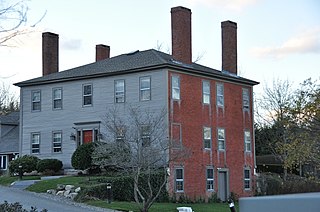
The Thomas Symonds House is a historic house at 320 Haverhill Street in Reading, Massachusetts. Built sometime between 1775 and 1836 by Thomas Symonds, Jr., it is the only Federal period brick-ended house in the town, and is unusually architecturally sophisticated for the period in the town. The house was listed on the National Register of Historic Places in 1984.

The Millard–Souther–Green House is a historic house at 218 Green Street in Stoneham, Massachusetts. Built c. 1700, it is one of the oldest buildings in Stoneham. It is a two-story timber-frame structure with an asymmetrical four-bay facade. The entry is in the second bay from the left, with the slightly off-center large brick chimney behind. It has an added rear leanto section, giving it a classic saltbox profile. The window openings appear to be original in terms of size and position, a rarity for Stoneham's 18th-century houses.
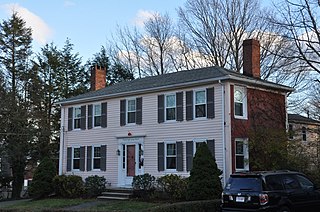
The House at 38 Salem Street in Wakefield, Massachusetts is a late Federal period house. The 2+1⁄2-story wood-frame house is believed to have been built c. 1810, and has locally unusual features, including brick side walls and a hipped roof. Its twin slender chimneys are indicative of late Federal styling. The front entry is topped by an entablatured with a compressed frieze, and is flanked by three-quarter sidelight windows.

The Dr. S. O. Richardson House is a historic house at 694 Main Street in Wakefield, Massachusetts, United States. Built in the late 1830s, this wood-frame house is one of the finest Greek Revival houses in Wakefield, and was the home of Dr. Solon O. Richardson, a locally prominent physician and real estate developer. The house was listed on the National Register of Historic Places in 1989.

Saint Joseph School is a private, Catholic school located on Gould Street in Wakefield, Massachusetts. It serves students from preschool to 8th grade.

The H. M. Warren School is a historic school building at 30 Converse Street in Wakefield, Massachusetts. Built c. 1895–1897, it is locally significant as a fine example of Renaissance Revival architecture, and for its role in the town's educational system. The building was listed on the National Register of Historic Places in 1989. It now houses social service agencies.

The Seth Davis House is a historic house located at 32 Eden Avenue in Newton, Massachusetts.

The Dunbar-Vinton House is a historic house at Hook and Hamilton Streets in Southbridge, Massachusetts, USA. Probably built in the early 19th century, it is locally unusual for its brick construction at that time, and may have been built as a district schoolhouse. It was listed on the National Register of Historic Places in 1989.
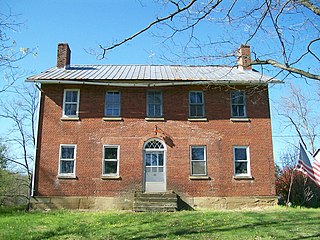
The Simeon Deming House is a historic residence in western Washington County, Ohio, United States. Located along Kern Road northeast of the community of Watertown, the house was built circa 1815 as the residence of a veteran of the American Revolution. A native of Sandisfield, Massachusetts, Deming enlisted in the Continental Army in 1780 and was later promoted to an officer's rank.























